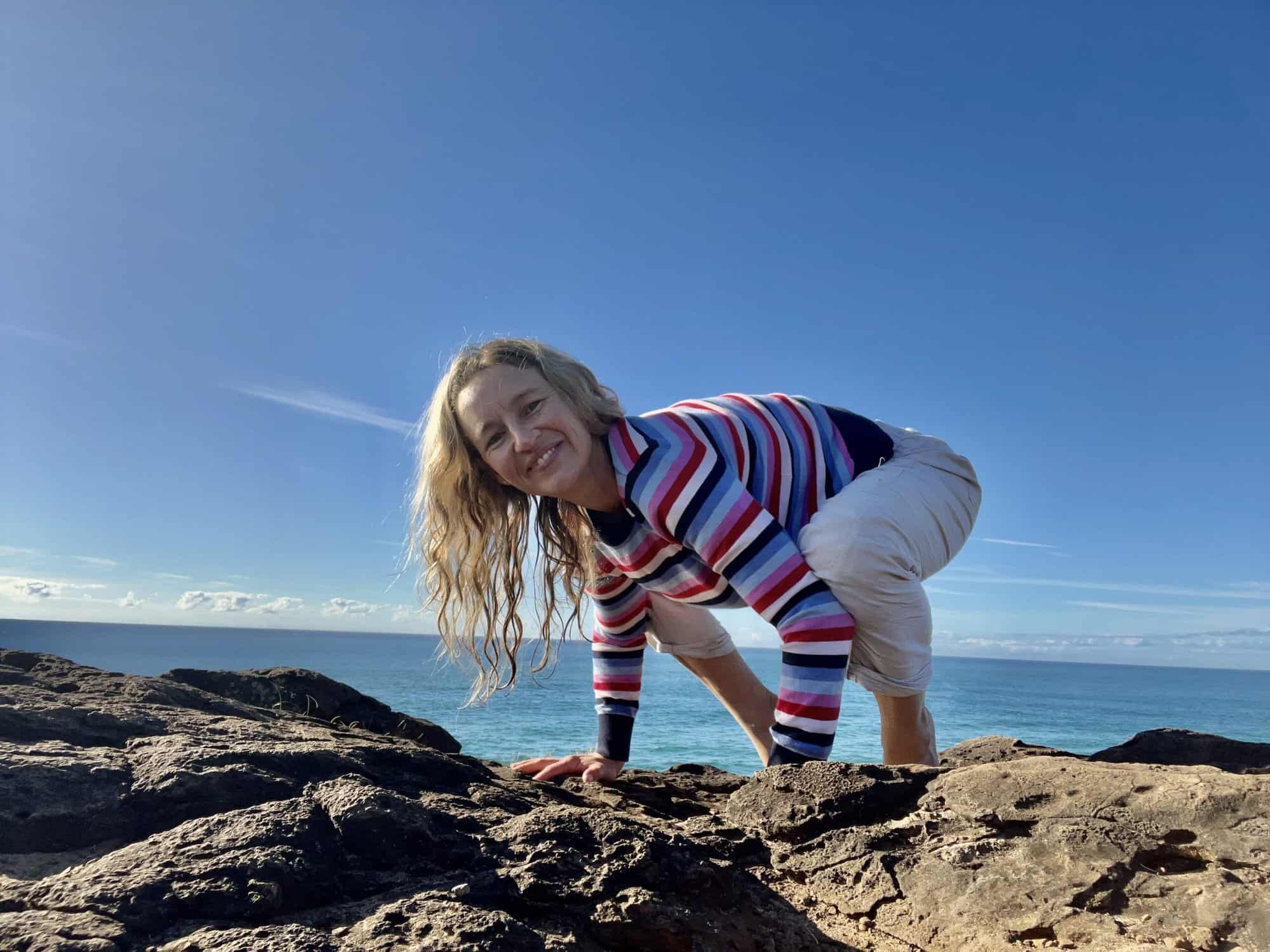Derived from the roots Baka = crane, and Asana = pose. Thus, Bakasana means “crane pose”.
How to Perform Bakasana
1. Begin by standing in Tadasana. Then, squat downwards and keep your inner feet a few inches apart. If you cannot place your heels on the ground, support them with a thickly folded blanket. Widen your knees greater than the width of your hips, and lean your body forward toward the inner thighs. Lengthen your arms forward and bend them at the elbow while placing them on the ground, firmly suctioning through the centre of the palm to protect your wrists. The back of the shoulders should be pressed against the shins.
2. Move your inner thighs to the side of your trunk, and see if you can place your shins into your armpits and upper arms down towards the shins as low as possible. Bend in the forward direction, putting the weight of your trunk on the back of your upper arms.

3. While in Bakasana, you have to consciously contract the front portion of your body and round your back. Suction up through your abdominal centre – uddiyana bandha. You can do this tuck and suction by keeping your tailbone as near to your heels as possible.
4. Exhale gently and bend forward evermore, leaning onto the back of your upper arms so that your feet are lifted off the ground. Now, you are balancing your trunk and your legs on the back of your upper arms. Beginners may stop at this point, where they are perched securely on their bent arms.

5. However, if you can go deeper into the pose: squeeze your legs against your arms and inhale, pressing your inner hands to the ground and stretching the elbows. The inner side of the knees should be touching the outer arms. The head should be kept in a neutral position, your gaze should be fixed on the ground, or you can lift your head slightly and focus your gaze forward.
6. Hold this pose for 20-60 seconds. To come back, exhale gently and slowly lower your feet to the ground to return to the initial squatting position.
Bakasana Benefits
Western Physiology
Bakasana has therapeutic effects on physical health.
- Bakasana stretches and strengthens the muscles:
- It helps in stretching the wrists and arms.
- It improves grip strength, which is a predictor of longevity.
- It helps strengthen the upper arms (Shiraishi & Bezerra, 2016).
- It helps in stretching the upper back.
- It helps strengthen the abdomen muscles (Shiraishi & Bezerra, 2016).
- It helps stretch into the inner groins and improves the strength and flexibility of the adductors.
- Other therapeutic effects of Bakasana include but are not limited to:
- It helps in toning the abdominal organs and improves core strength.
- This pose, amongst others, may help improve the quality of life for those who have ulcerative colitis (Cramer et al., 2017).
Yogic Physiology
- This is good for the heart prana – Vyana Vayu which is the movement of prana from the heart to the limbs.
- If you suction through the centre of the palms, you will be stimulating the Tala-Hridaya marma point, which is primarily for the health of the heart and circulation to the hands. This posture increases weightlessness, a feeling of lightness and increases Vata.
Chinese Medicine
You will work with the heart meridian that runs from the armpit to the little finger.
Contradictions and Cautions
- Individuals suffering from carpal tunnel syndrome should avoid this pose.
- People who suffer from wrist injuries may wish to avoid the pose.
- Pregnant females should avoid this pose.
Preparatory Asanas
- Adho Mukha Svanasana
- Baddha Konasana
- Balasana
- Plank Pose
- Virasana
Follow up Asanas
- Adho Mukha Svanasana
- Chaturanga Dandasana
- Plank Pose
Tips for Beginners
Beginners tend to move into this pose by lifting their buttocks high away from their heels. In Bakasana, try to keep yourself tucked tight, with the heels and buttocks close together. When you are ready to take the feet off the floor, push the upper arms against the shins and draw your inner groins deep into the pelvis to help you with the lift.
Variations
A great variation of Bakasana is a twist: Parsva Bakasana (pronounced PARSH-Vah, Parsva = side or flank). To do this, squat as described above, but keep your knees together. Exhale and turn your torso to the right, bracing the left elbow to the outside of the right knee. Work the arm with the knee until the knee is firm against the upper arm, near the armpit. With the hands on the floor, lean to the right and lift the feet off the ground on exhalation. Balancing with the outer left arm pressed against the outer right leg. Extend your arms as far as possible, but most students will have their elbows slightly bent. Hold for 20-30 seconds, exhale back to the squat, and repeat while leaning to the left for the same amount of time.
Modifications and Props
Some students have difficulty lifting off the floor. If this is the case, it is often helpful to prepare for this pose by squatting on a block or other similar props so that your feet are a few inches off the floor to start. Some students may feel more secure by placing a long bolster edge under their head so there is somewhere soft to land if falling.
Deepen the Pose
The full Bakasana sometimes causes varying degrees of pain in the wrists. So, instead of spreading the fingers on the floor, curl them slightly. This should take some of the pressure off of the wrists.
References
Cramer, H., Schäfer, M., Schöls, M., Köcke, J., Elsenbruch, S., Lauche, R., Engler, H., Dobos, G., & Langhorst, J. (2017). Randomised clinical trial: yoga vs written self-care advice for ulcerative colitis. Alimentary Pharmacology & Therapeutics, 45(11), 1379–1389. https://doi.org/10.1111/apt.14062
Shiraishi, J. C., & Bezerra, L. M. A. (2016). Effects of yoga practice on muscular endurance in young women. Complementary Therapies in Clinical Practice, 22, 69–73. https://doi.org/10.1016/j.ctcp.2015.12.007
If you would like to contact Celia to learn more about the meditation teacher training journey, please do visit our Meditation Teacher Training Page or find us on Facebook or Instagram or contact Celia directly.


